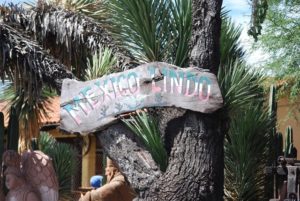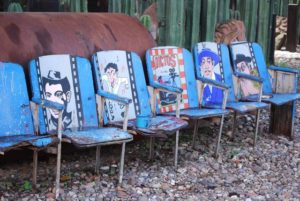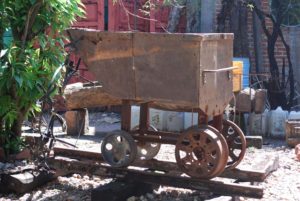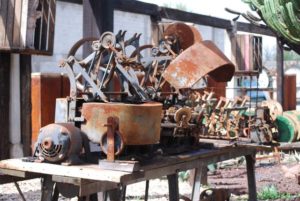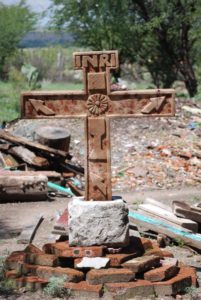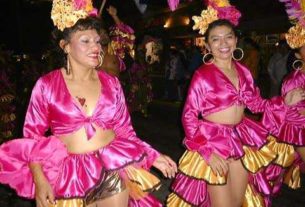An American acquaintance of mine, who believes himself to be quite astute about such things, is in the habit of asking whether San Miguel de Allende is the real Mexico and, if it’s not, where can it be found? I suppose the presence of 10,000 Canadians and Americans in this city of 75,000 puts him off a bit, as if his experience of the culture is diluted by their proximity.
I do know the answer to his question, but I’ve never told him what it is. The real Mexico is about twenty kilometers out of town on the road to Dolores Hidalgo, and it has come to rest in three fabulous junkyards. The most diverse is named México Lindo.
Junk here is called yonke. Because an initial “Y” is pronounced as “J,” the word sounds like “jonkay,” just as we use “joga” for our breathing exercises and pour “jogurt” over our fruit in the morning.
Mexico suffered 300 years of colonial history, almost all of it as Spain’s principle mining camp. Peru came in second. The proprietors hammered some of the silver into coins, poured the rest into ingots, and shipped it all home, unwittingly creating Europe’s first inflation. When the Spaniards gave up and departed in 1821, they left everything else behind.
Some of it is stacked up in exotic piles today on the Dolores Hidalgo road.
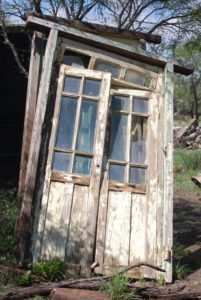
Walking through these meandering corridors as they lured me into the past, I was forced to speculate on the function of much of it. But that’s the essence of Mexico — we don’t always know what we’re looking at. Didn’t we all flee from Dubuque or Paducah to rekindle this sense of wonder?
Initially I thought this object must be the first mechanical outhouse, all previous versions being gravity powered. This had always worked without failure, except when a high wind entered through the spaces between the boards. The current contraption appeared to have the geared flushing mechanism mounted on the outside for easy maintenance. The Victorians, whose values once spread like a hopeful plague through the world, loved this kind of device, since they had unwittingly invented steampunk. The finger-grinding gears were never covered, since they wanted you to appreciate how clever they’d been. But did the occupant of this power flushing machine step out first? Or did the door opening on exit activate the flushing device via that curious winged lever at the left of the jamb? My suspicion is that we’ll never know, and I can’t imagine that any of us are now willing to test it.
Next, with relief, I came upon a less complicated device.
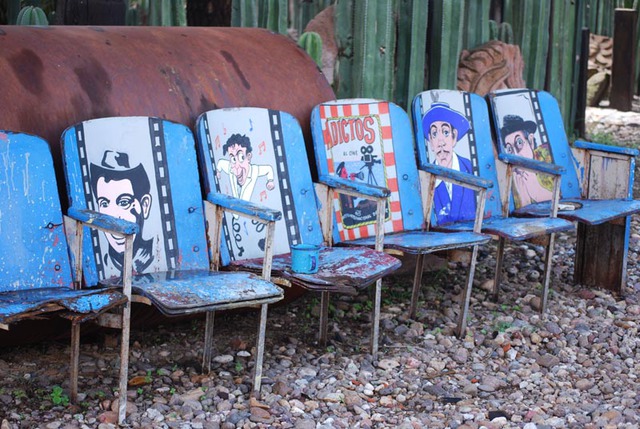
What a row of chairs this is! It features the great Mexican comic film star Cantinflas, who died in 1993. In the sixties, he owned a watering place near the Jardin in San Miguel called Posada Ermita. Were these chairs once part of one of his film shoots, where the extras would be seated as they awaited their cue? Or might they have been from his own bar? Whose pampered bottoms once warmed their contours? If only the delaminating plywood could speak to us now! But alas, the silence of death reigns in these precincts.
Ah, the mines. How much ore did this cart carry in its day? Guanajuato, our state capital, is bordered by a group of silver mines that includes the largest one in the world, the Valenciana, which produced 20 percent of the world’s silver for 250 years. It still operates now as a shadow of itself. The ore was brought down and crushed in various haciendas in that town, where it was then mixed with mercury to extract the silver. I wonder where the mercury is now? Time will tell, I suspect.
Doors, with a three-light transom. This yard holds more doors than you could walk through in a year. The mullions in this transom don’t line up with those in the doors below and the edges are molded differently. It never was a set. This is a cobbled together ensemble improvised to suit a pre-existing opening. The dangling hinges on the outer edge of the jamb suggest this frame also held screen doors at one time. Looking at the hinge knuckles, the existing doors also open towards us, as do the missing screens. But two pairs of doors hanging in the same frame must open in different directions to function. This set doesn’t make sense. It’s like looking at the past before it’s been processed by the historian, where we have only the raw material of contradictory facts.
These are disparate pieces of the real Mexico — it’s mostly here, but for the silver bullion. Yet you rarely know what you’re looking at because the pieces almost never fit together properly. Maybe that’s why my friend can’t find it.
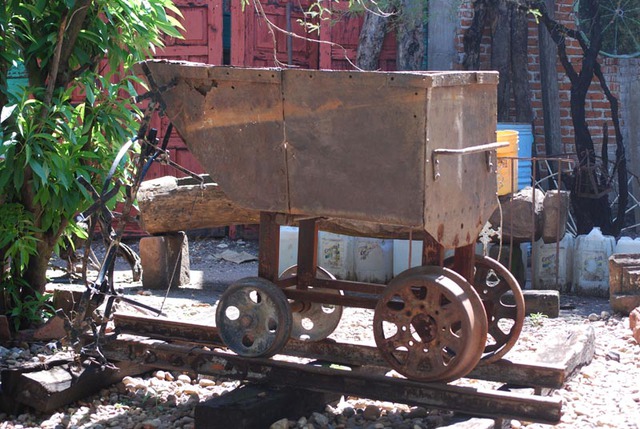
In the same vein, no piece on Mexico would be complete without touching on the simply inexplicable. This tabletop machine has the texture and color of a real artifact, and its level of engineering suggests a complex task. No one in this yard could tell me what it was or what it once did. I walked away thinking it was the ultimate example of not understanding what I was seeing. This can be a permanent condition here.
An old stone cross of mixed imagery comes from a country where Christianity reluctantly mated with dozens of older and equally strong local religions. The chalice in the center is clear, surmounted by either a sun, the Eucharist, or a flower. The INRI inscription at the top is common in this context. The square between is suggestive of nothing I know of. But what really stumps me are the three arrows, with the bottom one pointing not up, but to the left, the others outward to escape? If so, for whom?
None of this offers a solution. Nor does this sunny country, which mainly promises a refuge instead. No codebook can decipher it. As an observer, I write what I see, not what I know. No guidebook can untangle these muddy paths. I walked back out to the road with a sense of knowing no more or less than when I came, only of having covered more terrain. That’s the real Mexico — as in life, it’s the road more than the destination. Except here, be sure to bring your GPS.

